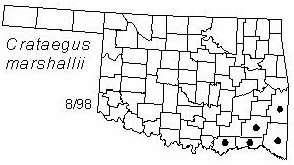Large shrub or small tree to 6 m (20 ft) in height and 10 cm (4 in) in diameter. Crown broad, irregular and open. Bark gray, peeling to reveal a reddish brown inner bark. Twigs light brown, pubescent; spines small, about 3 cm (1.2 in) long. Leaves alternate, simple, broadly ovate, 2-5 cm (0.8-2 in) long and 2-4 cm (0.8-1.5 in) wide, deeply divided into 5-7 narrow coarsely toothed lobes; glabrous, lustrous green above, paler beneath; truncate, cuneate, or subcordate at base, acute at apex, margins serrate; petiole slender, 2.5-5 cm (1-2 in) long and tomentose. Flowers in corymbs, villose, 3-12, often foul smelling, 1.5 cm (0.6 in) wide; calyx 5-lobed, often serrulate-glandular; petals 5, white; styles 1-3; stamens 20 with red anthers; flowers appear from March to April. Fruits pomes, 8 mm (0.3 in) in diameter, oblong to ovoid, bright red; seeds 1-2, smooth and rounded; fruits mature October to January.
Distribution: Oklahoma and Texas, east to Florida, north to Virginia and west to Missouri and Arkansas. Uncommon, restricted to southeastern Oklahoma.
Habitat : bottomland forest and moist soils.
Comments: Crataegus is from the Greek meaning "flowering thorn"; marshalli honors Humphrey Marshall (1722 - 1801), a Pennsylvania botanist and father of American dendrology, who first described parsley hawthorn.
Field identification: Parsley hawthorn can be readliy indentified by its unique leaves.
Horticulture: A beautiful small tree that is underutilized as an ornamental.
Wildlife benefits: In general, the fruits of hawthorn species are eaten by several species of birds. The dense branching pattern provides shelter and nesting habitat for several species of birds.
NWI status: none
Distribution in Oklahoma: 
BACK
NEXT
RETURN TO INDEX
Last update: 9/9/99
 Go to Oklahoma Biological Survey Home Page
Go to Oklahoma Biological Survey Home Page
 Disclaimer
Disclaimer